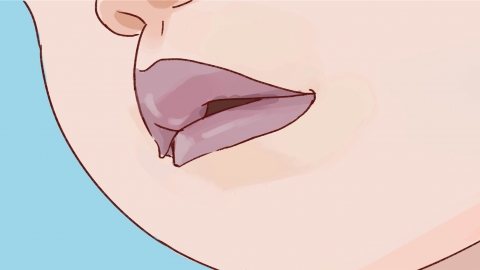What causes the lips to appear dark purple from childhood?
Generally, dark or purplish lips may be caused by hereditary factors, cold exposure, chronic cheilitis, chronic obstructive pulmonary disease (COPD), heart failure, and other conditions. It is recommended to seek timely medical consultation and follow the guidance of a physician for appropriate treatment. Detailed explanations are as follows:

1. Hereditary factors
Due to genetic reasons, some individuals may have increased pigmentation in the lip area, resulting in lips that appear darker than usual, even black or purple. This is caused by genes determining the activity and distribution of melanocytes, leading to increased melanin production in the lips. This physiological pigmentation caused by hereditary factors generally does not require special treatment.
2. Cold exposure
Remaining in a cold environment for a prolonged period may cause vasoconstriction of the lip blood vessels, slowing circulation and temporarily causing dark or purplish lips, often accompanied by cold hands and feet. It is recommended to keep warm promptly, such as by wearing a mask, drinking warm water, and avoiding cold environments. The lip color usually returns to normal gradually without medical intervention.
3. Chronic cheilitis
Chronic cheilitis is usually caused by multiple factors, such as long-term contact with irritants, sun exposure, and local allergic reactions. These factors may lead to chronic inflammation of the lip mucosa. Persistent inflammation can cause tissue proliferation and keratinization, affecting local blood circulation and metabolism, thereby causing dark or purplish lips. Symptoms such as dryness, scaling, itching, and pain in the lips may also occur. Patients should follow medical advice to use medications such as tacrolimus ointment, triamcinolone acetonide clotrimazole cream, and compound chlorhexidine mouthwash to reduce inflammation and promote mucosal repair.
4. Chronic obstructive pulmonary disease (COPD)
COPD is commonly caused by long-term smoking, air pollution, occupational exposure to dust and chemicals, among other factors. Patients develop irreversible airway obstruction, leading to impaired ventilation and gas exchange. Oxygen cannot adequately enter the bloodstream, and carbon dioxide elimination is hindered, causing chronic hypoxia throughout the body, which results in dark or purplish lips. Symptoms such as chronic cough and sputum production may also occur. Patients can use medications such as budesonide inhalation suspension, salbutamol sulfate aerosol, and ipratropium bromide aerosol as advised by a physician to dilate bronchial tubes, reduce airway inflammation, and improve ventilation.
5. Heart failure
Heart failure may be associated with psychological factors, metabolic disorders, anemia, and other causes. When cardiac pumping function declines, insufficient tissue perfusion and hypoxia throughout the body result in cyanotic lips. Symptoms such as extreme fatigue and leg edema may also occur. Patients may require heart transplantation as directed by a physician, which involves implanting a healthy heart to replace the damaged or failing one, thus restoring normal blood circulation.
In daily life, it is recommended to take sun protection measures to avoid excessive sun exposure of the lips; maintain a balanced diet and undergo regular medical checkups to detect diseases early and treat them promptly.










